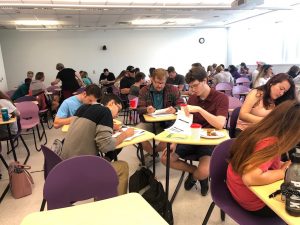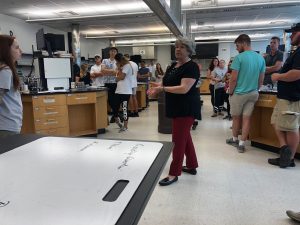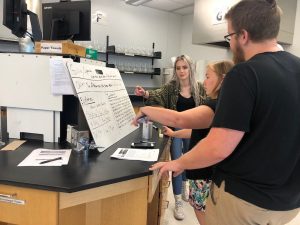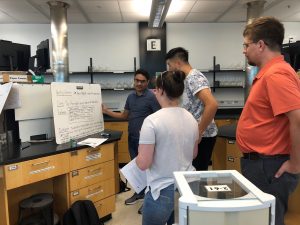Fall 2019
In August, the week before Fall classes, we host training for graduate teaching assistants in biology, chemistry, and physics. The program includes an overview of the evidence and research for active learning, techniques to foster dialog and provide feedback to students, managing groups, and an overview of the XLabs project. The rest of the day was spent conducting the ADI density investigation and completing all the components, proposal, data collection, argumentation and peer-review of sample reports. The GTAs were enthusiastic and engaged all day. The day before the joint event, there were discipline specific trainings for the subsets of GTAs, which oriented GTAs to the laboratory curriculum they would be teaching.
Fall 2019 schedule
Schedule (morning open to all new TAs; afternoon includes TAs from 6 ADI classes only)
9:00am Introduction, IRB consent, pre-survey (Breakfast provided)
9:15am Ice breakers
9:30am Why Students Learn Better being Active rather than Passive (short presentation and activity)
10:15am Break (snack and beverages provided)
10:30am Techniques to foster dialogue, ask questions, provide feedback to students, and help students work in groups
11:45pm Lunch (provided for those attending full day)
1:00pm Standardization of Labs across Disciplines, Observation Protocol, & Use of ADI to Prepare Students for Research
1:45pm Density Experiment
2:30pm Break (Snack and beverages provided)
2:45pm Mock Argumentation Session & Discussion
3:15pm Mock Session of Peer Review in Introductory Labs & Discussion
3:45pm Wrap up, final questions
4:00pm End
Fall 2020
Due to COVID19, the TA training was virtual in 2020. We created 4 videos. First, we required attendees to watch the first two and complete short-answer questions.
- Evidence-based Teaching
- Science of Learning
- ADI Overview
- ADI Research
Short Answer Questions for Videos 1 and 2 with examples of GTA responses.
- Provide an example from your own experience of evidence-based teaching.
In my experience taking STEM labs at ECU, I found the ADI method has made me think critically to improve my understanding of the investigations I carried out. Answers to questions were not just provided by an instructor, and I was encouraged to follow what the data says as opposed to what the outcomes were “supposed” to be.
In my advanced lab for physics we were able to actively engage in experimental design/setup/analysis. It was very effective in helping to understand theory and data analysis, and quite a departure from prior labs where the object was to simply follow the instructions provided.
An experience I have with evidence-based teaching was my inorganic lab at ECU. Every few labs, we would have an argument class where we would sit as a group and students alone would walk through questions and answers we had about the labs we had previously completed. The instructor would not interrupt or try and guide the conversation. In this way, we not only gained confidence in justifying our reasoning, but also learned to have solid evidence for our claims. We would also have to use information we had learned weeks ago to justify our ideas, which helped us better retain the information.
- What is the implication for the information provided on learning for lab instruction?
The brain isn’t permanently hard-wired, it in fact exhibits abundant plasticity or the ability to change. Knowing this, we teachers of any subject that requires the brain (virtually all subjects), must know that students can change. We must understand that thinking can mature with proper teaching implementation. Above all we must understand that preconceived notions affect learning and comprehension. In any given situation we cannot, consciously or subconsciously, make a student believe he or she is not able to accomplish the requirements of the stem field or learning in general.
When teaching labs, you have to open your “range” of explaining information. Some people may be more familiar with something than others. This example is given in the video as the chess board example. The chess masters did better because they made a connection between pieces and actual spots where pieces go. On the second board pieces were in any spot so all three groups of people did the same. When teaching a lab, you have to make sure you teach to your audience and make adjusted for those students who may not understand the information the first time. Do not single out students who may not have the same knowledge of other students. Make connections that cater to everyone.
Next, attendees watched an ADI Overview video and responded to a question asking them to list the different stages of ADI. Dr. Walker presented the ADI Overview with emphasis on specific areas that often challenge new GTA’s. This orientation prepared them for the activity that followed.




